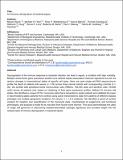| dc.contributor.author | Reyes, Miguel | |
| dc.contributor.author | Filbin, Michael R. | |
| dc.contributor.author | Bhattacharyya, Roby P. | |
| dc.contributor.author | Billman, Kianna | |
| dc.contributor.author | Eisenhaure, Thomas | |
| dc.contributor.author | Hung, Deborah T. | |
| dc.contributor.author | Levy, Bruce D. | |
| dc.contributor.author | Baron, Rebecca M. | |
| dc.contributor.author | Blainey, Paul C | |
| dc.contributor.author | Goldberg, Marcia B. | |
| dc.contributor.author | Hacohen, Nir | |
| dc.date.accessioned | 2020-06-22T15:59:53Z | |
| dc.date.available | 2020-06-22T15:59:53Z | |
| dc.date.issued | 2020-02 | |
| dc.date.submitted | 2019-12 | |
| dc.identifier.issn | 1078-8956 | |
| dc.identifier.issn | 1546-170X | |
| dc.identifier.uri | https://hdl.handle.net/1721.1/125914 | |
| dc.description.abstract | Dysregulation of the immune response to bacterial infection can lead to sepsis, a condition with high mortality. Multiple whole-blood gene-expression studies have defined sepsis-associated molecular signatures, but have not resolved changes in transcriptional states of specific cell types. Here, we used single-cell RNA-sequencing to profile the blood of people with sepsis (n = 29) across three clinical cohorts with corresponding controls (n = 36). We profiled total peripheral blood mononuclear cells (PBMCs, 106,545 cells) and dendritic cells (19,806 cells) across all subjects and, on the basis of clustering of their gene-expression profiles, defined 16 immune-cell states. We identified a unique CD14+ monocyte state that is expanded in people with sepsis and validated its power in distinguishing these individuals from controls using public transcriptomic data from subjects with different disease etiologies and from multiple geographic locations (18 cohorts, n = 1,467 subjects). We identified a panel of surface markers for isolation and quantification of the monocyte state and characterized its epigenomic and functional phenotypes, and propose a model for its induction from human bone marrow. This study demonstrates the utility of single-cell genomics in discovering disease-associated cytologic signatures and provides insight into the cellular basis of immune dysregulation in bacterial sepsis. | en_US |
| dc.language.iso | en | |
| dc.publisher | Springer Science and Business Media LLC | en_US |
| dc.relation.isversionof | http://dx.doi.org/10.1038/s41591-020-0752-4 | en_US |
| dc.rights | Article is made available in accordance with the publisher's policy and may be subject to US copyright law. Please refer to the publisher's site for terms of use. | en_US |
| dc.source | Prof. Blainey via Howard Silver | en_US |
| dc.title | An immune-cell signature of bacterial sepsis | en_US |
| dc.type | Article | en_US |
| dc.identifier.citation | Reyes, Miguel et al. "An immune-cell signature of bacterial sepsis." Nature Medicine 26, 3 (February 2020): 333–340 © 2020 The Author(s) | en_US |
| dc.contributor.department | Massachusetts Institute of Technology. Department of Biological Engineering | en_US |
| dc.contributor.department | Broad Institute of MIT and Harvard | en_US |
| dc.relation.journal | Nature Medicine | en_US |
| dc.eprint.version | Author's final manuscript | en_US |
| dc.type.uri | http://purl.org/eprint/type/JournalArticle | en_US |
| eprint.status | http://purl.org/eprint/status/PeerReviewed | en_US |
| dc.date.updated | 2020-06-19T13:44:35Z | |
| dspace.date.submission | 2020-06-19T13:44:38Z | |
| mit.journal.volume | 26 | en_US |
| mit.journal.issue | 3 | en_US |
| mit.license | PUBLISHER_POLICY | |
| mit.metadata.status | Complete | |
